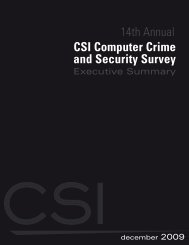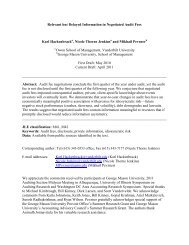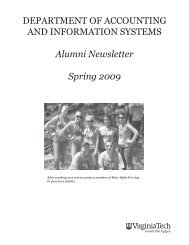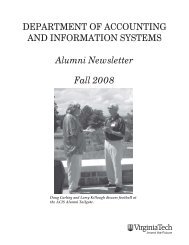2010/2011 Computer CrIme and SeCurIty Survey - Gatton College ...
2010/2011 Computer CrIme and SeCurIty Survey - Gatton College ...
2010/2011 Computer CrIme and SeCurIty Survey - Gatton College ...
Create successful ePaper yourself
Turn your PDF publications into a flip-book with our unique Google optimized e-Paper software.
<strong>2010</strong> / <strong>2011</strong> CSI <strong>Computer</strong> Crime <strong>and</strong> Security <strong>Survey</strong>As we lay out the detailed findings of our survey we will compare some of our survey results withthe findings of other studies. Thus it is imperative to first recognize the differences in each studypool. One study from the Ponemon Institute (sponsored by PGP Corporation) examined the costsincurred by 45 organizations that had experienced data breaches resulting in the loss of between5000 <strong>and</strong> 101,000 records. As Dr. Larry Ponemon, chairman <strong>and</strong> founder of the Ponemon Instituteexplained to us in last year’s CSI <strong>Survey</strong> report, the Institute purposely aimed at having a relativelyhomogenous study pool, specifically going after breach cases in which between 1,000 <strong>and</strong>about 100,000 records were disclosed. The breached organizations cover 15 different industry sectors—themost heavily represented industry sectors were financial services <strong>and</strong> retail, with eightbreaches each. Ponemon also told us that the Institute’s report is best viewed as a synthesis ofcase studies of confirmed data breaches, as opposed to a more sweeping survey.Verizon Business’ Data Breach Investigations Report (DBIR), now in its third installment, looks ata growing library of cases ranging from 2004 to the present. This year, for the first time, the DBIRalso incorporates a case database obtained from the U.S. Secret Service, which is listed as a cosponsorof the report. Perhaps the most salient feature of the demographics here is that the entiresample comes from organizations that have suffered major data breaches. Given that banks arewhere the money is, it’s not surprising to learn that the case load heavily tilts toward financial institutions,with 33 percent of cases, followed by 23 percent in the hospitality industry. That over halfof the cases come from just two industries, though, may well seem problematic if one is trying toget a sense of the general level <strong>and</strong> nature of threat to enterprise network.Also worth nothing in passing is that some of the cases in the DBIR database (specifically, fromVerizon’s case load) are from outside the U.S., <strong>and</strong> therefore outside the scope of the CSI <strong>Survey</strong>.Other reports worth considering alongside the CSI report take a more machine-generated approachto the data, using sensors of various types to capture information about the data traversingnetworks <strong>and</strong> the configuration of all sorts of Internet-connected devices. One example of thissort of report is the MessageLabs Intelligence report, issued monthly by Symantec subsidiaryMessageLabs. In this report, the primary data comes from mail traffic filtering that the company’sservices provide. Generally, this sort of report has the virtue of being highly accurate. When thereport tells us that 87.5 percent of the mail traffic it h<strong>and</strong>led in October was spam <strong>and</strong> that thiswas a 4.2 percent decrease from September, it is likely that these numbers may be taken at facevalue. The 4.2 percent decrease is not plus or minus some amount, rather there were some exactnumber of mail pieces fewer that amounted to an exactly 4.2 percent drop. This sort of exactitudeisn’t everything, though. Definitions such as what counts as spam can be highly significant—howdoes MessageLabs know that what it didn’t count as spam really wasn’t spam? And the interpretationsof these numbers is what really counts in day-to-day provision of security. Perhaps it doesn’tmatter that so much spam gets sent because it is benign, for instance.8











